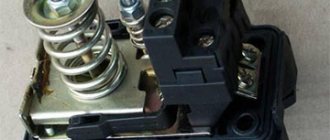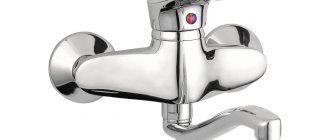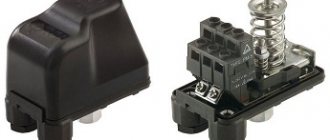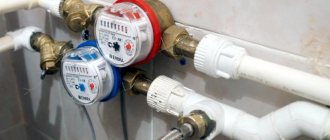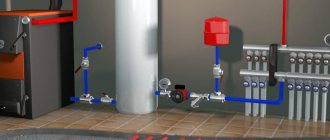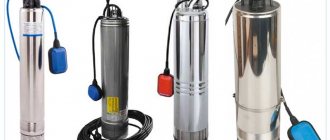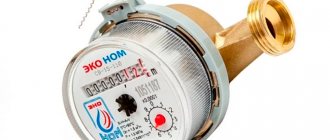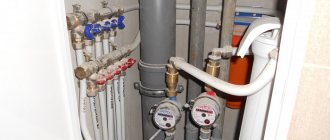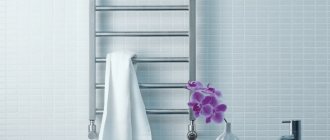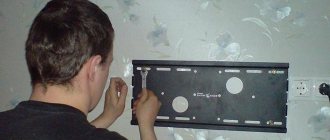Modern man has learned to value comfort and, accordingly, is very demanding about living conditions. No surprise, the amenities are good. And when something is missing, to put it mildly, it’s not very good. The same thin stream of drinking liquid from the tap instead of an impressive pressure becomes a serious problem. Especially if this cannot be called an exceptional case. To eliminate this annoying nuisance, you need to understand why the water pressure reducer is adjusted in the water supply system in the apartment.
What is the RDV and how does it work?
The number of atmospheres in the water supply during the supply of water resources is, unfortunately, unstable. The discharge constantly fluctuates up or down. For users living in apartment buildings, this is very inconvenient. In addition, sudden surges in pressure can lead to failure of hydraulic structures and even cause breakthroughs.
In order to prevent disastrous consequences, special devices - regulators - are installed in hydraulic systems. With their help, it is possible to stabilize the pressure level, thereby protecting the internal network from excessive overloads and water hammer. The latter make themselves known quite often from the central highway.
Equipment
Reducers can be equipped with pressure gauges for visual monitoring of pressure and the ability to regulate pressure according to instrument readings.
Regulators can be produced in the same housing with a coarse filter. For use in pumping stations, automatic pressure regulators are used.
More modern gearboxes are equipped with an electronic unit that allows you to control the pump using an installed program. There are regulators with an electric rod drive that operate based on a signal from an electric pressure sensor. Such devices require a constant power supply.
How to adjust the water reducer in an apartment and is it really necessary?
A device that allows you to control the amount of atmosphere in the water supply is simply irreplaceable in most cases. It acts as a restraining protective factor that protects the hydraulic network from harmful fluctuations and excess load. It must be installed if at least one of the problems occurs:
- Lack of stable pressure. When tap liquid initially flows from the tap in a thin stream, but after a couple of seconds it almost knocks down the person standing near the sink - do not delay installing the unit. Sudden pressure surges become the root cause of breakdowns of household appliances and communications. In addition, such instability poses a direct danger to users (thermal burns).
- Too much water flow. In such a situation, the installation of a reduction gearbox is required. Owners of apartments on the ground floor most often encounter a similar problem. This happens because H2O is supplied to high-rise apartment buildings with great force. Otherwise, it simply will not rise to the required level and residents of the upper levels will be left without water. When a residential building is located near a pumping station, inflated indicators become commonplace. Because of this, connections fail with alarming regularity, leaks form, etc. But a custom reduction unit helps eliminate all these difficulties.
- Weak pressure. In this case, it is worth installing a device equipped with a pump. Thanks to this device, you can forever forget about the thin trickle from the tap, which prevents you from taking a normal shower, washing dishes or connecting any household appliances.
Honeywell D04FM-1/2A
Powerful “small”: will give peace and security.
Product from the rating
Water pressure reducer Honeywell D04FM-1/2A 4 reviews
In stock
Type: membrane | Output pressure range, bar: 1.50, 6 | Diameter (inch), ": 1/2, 3/4 | Maximum inlet pressure, bar: 16 | Protection against: dynamic pressure | Suitable: for hot water, for cold water |
| + Advantages | - Flaws |
| Product from a German brand. Dynamic pressure protection. Compact sizes. The adjustment spring does not come into contact with drinking water. Suitable for domestic and commercial systems. | No pressure gauge. |
If you are looking for a reliable device to protect old water pipes and household appliances, be sure to take into account the model from the German manufacturer Honeywell. This device deservedly made it to the top of water pressure reducers. It is suitable for home use and for use in commercial plumbing systems (within its technical specifications).
The Honeywell D04FM-1/2A body is made of nickel-plated brass. The spring is made of high-strength spring steel. The design of the product does not imply contact of water with the spring element, so the gearbox can be used for a water supply system supplying drinking water. The regulator does not affect the taste of the liquid in any way.
The Honeywell brand model will prevent dangerous manifestations of dynamic pressure in the line. In case of a sharp drop, it will equalize the pressure to a safe value (must be specified in advance).
Due to its small dimensions, the Honeywell pressure reducer can be installed both in an already functioning system and in those that are just being designed. In order to monitor the current pressure, the gearbox can be equipped with a pressure gauge.
The unit is suitable for cold and hot water pipes. The only negative is that it does not guarantee protection against static pressure. The model is designed for external pressure up to 16 bar. The output value can be set from 1.5 to 6 bar.
Expert comment: it is advisable to purchase a coarse filter, which will contribute to more efficient operation of the gearbox.
Compare this unit with other models in the Honeywell D04FM series to find the right product for your plumbing needs.
Design features and operating principle
Before adjusting the gearbox settings, you need to find out how the water pressure regulator in the apartment works and what it is. The RDV is equipped with a durable metal body and a threaded connection. So that the consumer can manually adjust the fluid flow at any time, the unit is equipped with a special screw and pressure gauge.
In water supply systems of private residential buildings, stabilization is carried out using a relay and a hydraulic accumulator installed in a main outlet. It is these devices that correct the actions of the pumping station. Regulatory mechanisms are installed in networks:
- water intake;
- irrigation;
- fire protection;
- communal;
- technological
The design of various RDVs is largely similar. All of them have a valve, piston, membrane-spring unit and control elements.
During operation of the gearbox, the flow of the liquid medium passes through the membrane and spring, stabilizing at the outlet. This protects the water supply system from excessive overloads and fluctuations in H2O supply.
How to disassemble the device - step by step steps
Many RDV owners encounter difficulties with repairs or maintenance . You can disassemble and reassemble the gearbox yourself; most devices have a simple internal mechanism and come with clear instructions.
Most often, gearboxes are disassembled to reduce or increase throughput and to clear accumulated debris.
It is recommended to disassemble the RDV for maintenance once every six months, or when it becomes dirty. It is necessary to wash the internal mechanisms with special solvents for water pipes. The valve must be lubricated before assembly, if possible.
Tools
To disassemble and clean the water pressure reducer, you need a wrench or a set of screwdrivers. The choice of tool depends on the type and model of the device. Almost all devices are adjusted manually ; the gearboxes are disassembled with a regular wide screwdriver.
Parsing process
When disassembling, it is important to remember the order of the internal parts, especially if it is a piston or electronic gearbox.
The parsing process itself consists of several steps:
use a screwdriver to unscrew the housing cover;- disassemble the internal connection consisting of a rod and pistons;
- remove the O-ring and inner spring;
- clean and lubricate the housing and its internal elements;
- replace sealing material.
Types of regulators
Devices for regulating pressure are divided into several types. Each of them should be considered in more detail.
Piston
This species is most popular among consumers of water resources. Widespread use is largely due to its relatively low cost. It operates due to a piston, which increases or decreases the cross-section of the pipe accordingly. The required flow level can be set using a rotating valve. The output range varies from 1 to 5 atmospheres.
Among the disadvantages of this type of unit, it is worth noting the increased sensitivity of the piston system to the ingress of polluting particles, which leads to breakdowns.
Membrane
When figuring out how to regulate (adjust) the water pressure valve in the reducer in an apartment, it is important to remember that such devices have many advantages over analogues. Among them:
- the ability to adjust the pressure within 0.5-3.0 cubic meters per hour;
- the spring-membrane mechanism is located in a sealed compartment;
- reliability of design;
- undemanding during operation.
MBFT-75 Membrane for 75GPD
SF-mix Clack up to 0.8 m3/h
SF-mix Runxin up to 0.8 m3/h
At the same time, such units are very expensive. They also have many moving elements, which complicates repairs.
Flow-through
There are no moving parts in devices of this type. This is a big plus, since they break much less often and last longer. The devices ensure flow movement through constant rotation of the liquid along an internal labyrinth circuit.
The reasonable price for such models is explained by the use of plastic elements during assembly. The only thing is that the consumer will have to purchase a separate inlet valve, but this is not particularly difficult. The operating range is 0.5-3.0 atmospheres.
Automatic
Such regulators control the force of water movement in the water supply network due to the membrane. The degree of compression of the spring mechanism depends directly on the pressure. The contacts alternately close and open, thereby activating or turning off the pump. With the help of a relay, the pressure is stabilized.
Electronic
Units of this type maintain a certain level of liquid medium in the pipeline, starting the pumping station if necessary. A special sensor reads the information received by it. If there is no liquid in the pipes, a corresponding signal is given and the pump device does not operate.
The necessary parameters are set on the panel, where the characteristics of the water resource supply are displayed. Regulators of this type are more reliable and almost silent. In domestic use, they are much more efficient than their mechanical counterparts.
To achieve ideal drinking quality in a house or apartment, it is necessary to equip the water supply system with filtering equipment. The necessary cleaning devices can be found on the website.
How is it different from a pressure gauge?
Pointer or electronic ones have a built-in pressure gauge, but this is only part of the sensor design. The indicating device measures and displays the pressure value on a dial or electronic display.
The sensor additionally converts the threshold values into a signal, which it sends to the pump, triggering the equipment to turn on or off.
In inexpensive models, the accuracy of readings is low . In a circuit with a sensor in the lower price segment, even if there is an indicator, a separate high-sensitivity pressure gauge is often included.
Tips for choosing: what is better to install
When planning to purchase a regulator device, you should pay attention not only to its type, but also to other characteristic features. Most often, its effectiveness depends on them.
Compound
Gearboxes used in everyday life are usually mounted on a thread. When choosing the right model, take a closer look at the connection size, measured in inches. The standard RDV has a diameter of ¾. ½ or 2 options may also be presented. To determine the correct parameters, it is enough to measure the internal water supply pipe where the unit is supposed to be installed.
Performance
In apartments, devices with a maximum value of 3 cubic meters per hour are usually installed. The given volume is fully sufficient for the household needs of the residents. In public and industrial buildings, more powerful regulators are installed - from 3 to 15 m³/h and higher.
Temperature
When going shopping, you should remember that not all gearboxes are designed for domestic hot water systems. Please note the relevant specifications. The device must function stably at a temperature of 130º C. The control unit for cold water does not need such heat resistance.
Material used in production
Of course, all practical, reliable and long-lasting models are made from high-quality parts that are resistant to rust. As a rule, it is chrome-plated brass or stainless steel.
SF-mix manual up to 0.8 m3/h
AMETHYST - 02 M up to 2 cubic meters/day.
Aeration unit AS-1054 VO-90
Design features
Devices with a piston system are very resistant to wear. However, they are still not particularly reliable due to increased sensitivity to contaminant particles in tap liquid. They fail quite quickly if the H2O supplied to the home is of inadequate quality. Here the question will most likely arise not of how to adjust the water pressure regulator valve in the apartment, but of how to change it.
Units with a membrane are much more practical in this regard. They are unpretentious in use and maintenance. If the operating rules are strictly followed, they operate for a long time without interruption. The main thing is to constantly monitor the condition of the membrane part.
Established standards
Regulatory requirements include the following:
- The RDV is obliged to maintain pressure up to 0.3 MPa;
- the output should be no more than 0.04;
- throughput - 0.5 l/s;
- the number of launches is at least 250,000, taking into account a service life of up to 10 years or more.
Technical specifications
Manufacturers produce gearboxes with different characteristics. To determine which type of device is optimal, you need to carefully study the relevant information. As a rule, all the necessary information is presented in the device data sheet or directly on its rear panel.
Production quality
The unit must be made of durable, reliable material. When choosing the right model, try not to settle for the cheapest options. Remember a simple rule - a good thing cannot cost a penny. Also, pay attention to the weight of your purchase. Heaviness indicates the presence of metal parts in the structure.
Part 4. The age-old question: piston or membrane?
If your budget and installation dimensions allow, then you definitely need to choose a diaphragm type pressure reducing valve. The operational advantages of diaphragm gearboxes over piston valves are undeniable.
Advantages of piston gearboxes
- Low cost
- Compactness
Disadvantages of piston gearboxes
- Strong dependence on water quality, mandatory installation of a filter in front of the gearbox
- Wear of moving parts (piston seat, seals)
- In case of “bad” water, it is possible to install the valve only with the adjusting spring upwards
- Pressure maintenance accuracy is lower
- Works well in dynamic mode, worse in static mode
Advantages of diaphragm gearboxes
- No rubbing parts, longer service life
- Higher pressure maintenance accuracy
- Lower water quality requirements
- Higher throughput
- Most gearboxes are equipped with a filter element (mesh), additional protection
- Possibility of cleaning the gearbox filter
- Works well in both static and dynamic modes
Disadvantages of diaphragm gearboxes
- High price
Explanation! Dynamic mode is when there is water intake (water flow). Static - when the flow is static (water does not flow). Piston gearboxes work better in dynamic mode. When switching from dynamic to static mode, pressure may increase.
Gearbox installation
The regulator must be installed at the beginning of the pipeline fittings designed to shut off the flow of liquid, in front of the metering devices. This will achieve greater efficiency and simplify the maintenance process. In addition, meters, filters and other hydraulic equipment will be protected.
Accommodation in an apartment
Before carrying out installation work, you should correctly assemble the RDV and test the integrity of the plugs. The control device is placed between the adjustment taps in a strictly vertical position. Taking into account that the pipe runs exactly horizontally.
If you intend to use polypropylene elements, you must ensure that adapters are available. Usually they come immediately in a prefabricated kit.
The installation of the unit must include a filter mesh and a valve for controlling the liquid. The connection areas will need to be laid with FUM tape. At the end of the work, it is necessary to tighten the connecting joints. The main thing is not to overdo it and not break the nuts.
Installation in a private house
The installation process here is practically no different from that described above. The only difference is the pump, which serves to maintain the required pressure. The control device is installed in the area where the main outlet coincides with the supply network. Many manufacturers produce regulators and pumps as a set. But in some cases you will have to purchase an additional pumping mechanism.
It is quite difficult to install on your own. If you are not confident in your own experience and certain knowledge, it is better to entrust this work to specialists.
Main table dispenser AquaPro 919H/RO (hot and cold water)
Main table dispenser AquaPro 929CH/RO (cooling/heating)
Floor dispenser AquaPro 311 (empty, without cooling)
Self-configuration
Studying articles and videos on adjusting the hot water pressure reducer sensor in an apartment, it is easy to understand that the process involves a step-by-step implementation. In fact, it can be broken down into two stages.
Preparatory
Depending on the design features of the selected model, you may need certain tools:
- hexagonal slot 4-6 mm;
- regular flat screwdriver;
- special (universal) wrench for 2-20 mm;
- a pressure gauge that allows you to control pressure;
- adapter for connecting to a shower hose or faucet.
Direct setup
After careful preparation, you need to do the following:
- turn off all taps in the internal system;
- place the pressure gauge-controller on the regulator or connect it to the pipeline;
- using a valve, let the liquid flow through the pipe with minimal pressure;
- record the readings from the meter;
- unscrew the plug from the hole where the adjustment screw is located;
- taking a suitable tool (for example, a screwdriver), carefully rotate the screw element clockwise, as a result the spring will press on the valve and it will begin to slam shut with less atmosphere;
- to increase the flow force, it is necessary to rotate in the opposite direction;
- All that remains is to test the installation and disconnect the pressure gauge.
What types are there?
Controllers are distinguished by the complexity of their design and the set of commands that they are capable of sending to the system:
Mechanical sensors consist of a housing with one outlet for connection to a branch pipe.
These are the cheapest models, without pressure indication. The range is adjusted by eye, by turning the clamping nuts on the springs.- Pointers have a screen with two arrows, which show the upper and lower limits and are set with screws. They are supplied with a plug for connecting to the mains and a socket for connecting to the pump.
- Electronic differ from each other in their set of functions:
- they all control the pump, turn it on or off when the pressure leaves the specified range;
- show the current pressure value on the screen, allowing for fine tuning;
- protects against dry running with automatic multiple restarts;
- warn about leaks or ruptures of the pipeline, display an error code on the display to diagnose problems;
- in the most advanced models, a fault indication of the hydraulic accumulator has been added, which is displayed in the event of damage to the membrane or bleeding of air from the tank.
How to adjust water pressure in an apartment and remove standard settings
The need to deviate from standards may arise for a number of reasons. The main ones should be listed:
- if the consumption of water resources significantly exceeds the power characteristics of central systems and pumping complexes (low flow force);
- location on the upper levels of multi-storey buildings (lack of H2O);
- the opposite situation is when housing is located at the very bottom of the building (excess p);
- pumps do not work correctly, frequent fluctuations (jumps in indicators) occur.
In such cases, it is necessary to reconfigure the adjusting device. In addition, the pressure may change over the long period of operation of the water supply system. For example, the cross-section of pipes may decrease due to the abundance of rust and other types of internal deposits. In this situation, you will have to make adjustments more than once.
What will happen if you do not adjust the water pressure valve in the apartment, do not adjust the regulator
In the absence of timely adjustment, no particularly dangerous consequences will occur. This is if we look at the issue from a global point of view.
Low pressure will make it impossible to connect useful household appliances to the internal network, take a normal shower or wash dishes. Excessive can lead to numerous breakdowns of communications and the same equipment used in everyday life. Therefore, it is still necessary to regulate the supply in order to avoid common problems due to refusal to carry out regulatory measures.
Tips for use
Before installing the device, be sure to carefully read the included installation manual. The devices differ from each other and have different connection methods. Without certain experience, skills and abilities, it is better not to undertake installation work. Doubts in your own abilities are a good reason to invite a competent specialist.
It is necessary to monitor how the unit operates. If a leak is detected or the setting does not give the desired result, most likely the regulator has failed. It will need to be repaired or replaced with a new one.
Do not hesitate to install or replace the device. This way, you not only deprive yourself of comfortable living conditions, but also risk flooding your neighbors if communications break down.
